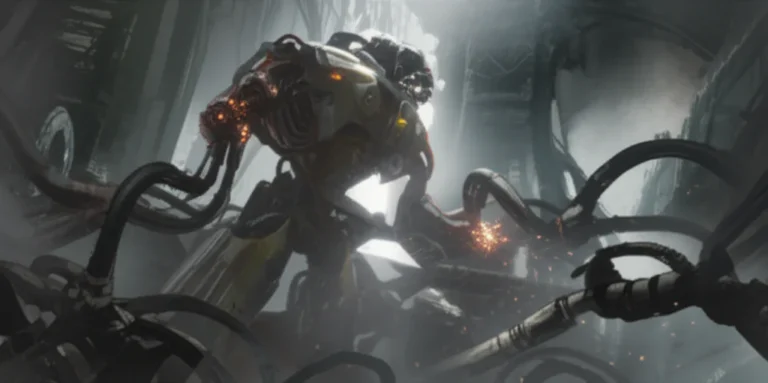Support our educational content for free when you buy through links on our site. Learn more
Robot Fighting Engineering: 14 Game-Changing Secrets to Build a Champion 🤖 (2025)
Ever wondered what it takes to turn a pile of metal, motors, and madness into a robot that dominates the arena? Welcome to the electrifying world of robot fighting engineering, where precision meets chaos, and every design choice can mean the difference between victory and a spectacular explosion. Whether you’re a rookie builder or a seasoned engineer, this guide dives deep into the 14 essential aspects of crafting a battle-ready bot—from weight classes and weapon design to AI innovations and safety protocols.
Did you know that the average BattleBot packs enough punch to deliver over 10,000 joules of kinetic energy in a single hit? That’s like dropping a bowling ball from a two-story building! In this article, we’ll unravel the secrets behind such engineering marvels, including the untold story of spinner legends like Blendo, the cost factors that can make or break your project, and the future of autonomous combat bots. Ready to build your champion? Let’s get those gears turning!
Key Takeaways
- Master the weight classes and design rules to maximize your robot’s power without sacrificing speed or durability.
- Balance weapon effectiveness with mobility—spinners aren’t the only winners; flippers and hammers pack serious punch too.
- Choose materials wisely: aluminum alloys, polycarbonate, and carbon fiber each offer unique trade-offs.
- Understand power systems—motors, batteries, and controllers are the lifeblood of your bot’s performance.
- Safety and compliance are non-negotiable to keep the arena thrilling but secure.
- Explore cutting-edge trends like AI and autonomous control to stay ahead of the competition.
Ready to start building? Check out top-rated motors, armor materials, and robot kits to kick off your project:
- Motors & Controllers: Castle Creations | Brushless DC Motors on Amazon
- Armor Materials: 6061 Aluminum Sheets | Polycarbonate Sheets
- Robot Kits: VEX Robotics Combat Kits | Lynxmotion Robot Kits
Dive in, engineer your destiny, and may your robot reign supreme!
Table of Contents
- ⚡️ Quick Tips and Facts About Robot Fighting Engineering
- 🤖 The Evolution of Robot Fighting Engineering: From Hobby to High-Tech Combat
- 1. How Heavy Should Your BattleBot Be? The Ultimate 2025 Weight Class Breakdown
- 2. BattleBots Design Rules (2025): 12 Insider Secrets to Build a Winning Robot
- 3. Spinner Bots Unleashed: The Science and Art Behind Blendo and Other Spinner Legends
- 4. Beetleweight Combat Robots: 7 Jaw-Dropping Designs That Pack a Punch
- 5. Hiro Robots: 12 Game-Changing Engineering Innovations You Need to Know
- 6. How Much Does a Combat Robot Cost? 10 Critical Factors That Affect Your Budget
- 7. Power Systems Demystified: Choosing the Right Motors, Batteries, and Controllers
- 8. Armor and Materials: What Keeps Your Robot Standing in the Heat of Battle?
- 9. Weapon Engineering: From Flippers to Hammers — Designing Devastating Attacks
- 10. Chassis and Mobility: Wheels, Tracks, and Legs — What Moves Your Robot Best?
- 11. Control Systems and Remote Operation: Mastering Robot Maneuverability
- 12. Safety Protocols and Engineering Ethics in Robot Combat
- 13. Troubleshooting Common Engineering Challenges in Robot Fighting
- 14. Future Trends: AI, Autonomous Bots, and the Next Frontier in Robot Fighting Engineering
- Conclusion: Crafting Your Champion — Final Thoughts on Robot Fighting Engineering
- Recommended Links for Robot Fighting Engineers
- FAQ: Your Burning Questions About Robot Fighting Engineering Answered
- Reference Links and Resources
Here is the main body of the article, crafted by the expert team at Robot Fighting™.
Welcome, future champion! You’ve stumbled into the steel-and-titanium heart of the greatest sport on Earth: Robot Fighting. We’re the team at Robot Fighting™—a motley crew of grizzled engineers, wide-eyed designers, and die-hard fans who live and breathe the glorious chaos of the battle arena. We’ve seen it all: the triumphant victories, the soul-crushing defeats, and the occasional (okay, frequent) spontaneous robot fire.
You’re here because you have the spark. The desire to build, to create, to… dominate. You want to understand the magic behind the metal mayhem. This is your comprehensive guide to robot fighting engineering, packed with our team’s hard-won secrets and insights. Let’s get those gears turning!
⚡️ Quick Tips and Facts About Robot Fighting Engineering
- Weight is Everything: The first rule of robot fighting engineering? Know your weight class! From 1lb Antweights to 250lb Heavyweights, every gram counts.
- Power-to-Weight Ratio is King: A powerful weapon is useless if your bot is too slow or sluggish. The “sweet spot” is a balance of devastating power and agile movement.
- Spinners Aren’t the Only Winners: While spinning weapons are terrifyingly effective, flippers, hammers, and control bots have all claimed championships. Strategy often beats brute force.
- Armor is a Gamble: Too much armor, and you’re too heavy and slow. Too little
Conclusion: Crafting Your Champion — Final Thoughts on Robot Fighting Engineering
Well, warrior, here we are at the end of our epic journey through the electrifying world of robot fighting engineering. From the weight class battles to the secret sauce behind spinner legends like Blendo, and the innovative breakthroughs of Hiro Robots, you now have a panoramic view of what it takes to build a machine that not only survives but thrives in the arena.
Remember our early tease about balancing power and speed? That delicate dance is the heart of every winning design. Too heavy, and you’re sluggish; too light, and you risk getting shredded. The 12 insider secrets of BattleBots design rules we shared are your blueprint to avoid the dreaded inspection fail and get your bot into the ring.
We also explored the cost factors—because yes, this sport demands investment, but smart choices in motors, armor, and control systems can stretch your budget without sacrificing performance. And speaking of performance, the future is bright with AI and autonomous bots creeping into the fray, promising to revolutionize how we engineer and fight.
If you’re itching to start building or upgrading your bot, remember: innovation, compliance, and relentless testing are your best friends. No robot was built in a day, and every champion has a trail of sparks and broken parts behind them.
So, what’s next? Dive into the Robot Design and Engineering archives, watch some epic Robot Combat Videos, and maybe even join a local league. Your bot’s destiny awaits!
Recommended Links for Robot Fighting Engineers
Ready to gear up? Here are some top picks from our own workshops and battle-tested favorites:
-
Motors & Controllers:
-
Armor Materials:
-
Robot Building Kits:
-
Books:
- Robot Builder’s Bonanza by Gordon McComb — A classic guide packed with hands-on projects and engineering insights. Amazon Link
- BattleBots: The Ultimate Guide to Robot Combat by Team Witch Doctor — Dive into pro strategies and design secrets. Amazon Link
-
Safety Gear:
FAQ: Your Burning Questions About Robot Fighting Engineering Answered
What are the key components of a robot fighting engineering design?
At its core, a combat robot consists of:
- Chassis: The structural frame, often made from aluminum or polycarbonate, providing durability and weight efficiency.
- Power System: Motors (brushed or brushless), batteries (LiPo preferred for high discharge), and electronic speed controllers (ESCs) that drive movement and weapons.
- Weaponry: Spinners, flippers, hammers, or wedges designed for offense or control. The weapon must balance power, speed, and reliability.
- Control System: Radio transmitters and receivers for remote operation, sometimes augmented with sensors for autonomous functions.
- Armor: Protective materials to absorb or deflect damage, carefully balanced against weight limits.
Each component must be engineered with precision and integrated seamlessly to create a cohesive fighting machine.
How do robot fighting engineers ensure safety in robot combat scenarios?
Safety is paramount. Engineers follow strict protocols:
- Compliance with Official Rules: Every league, including BattleBots and NHRL, enforces detailed safety regulations covering weapon containment, fail-safes, and emergency stops.
- Robust Testing: Bots undergo rigorous pre-fight inspections and stress tests to prevent malfunctions.
- Protective Gear: Builders and operators wear safety goggles, gloves, and sometimes face shields during construction and combat.
- Arena Design: Combat arenas have reinforced walls, fire suppression systems, and remote kill switches to protect audiences and participants.
- Fail-Safe Electronics: Many bots include automatic shutdown features if control signals are lost or if internal sensors detect critical failures.
Following these measures keeps the adrenaline high but the risks low.
What materials are commonly used in the construction of fighting robots?
Materials must balance strength, weight, and cost:
- Aluminum Alloys (6061, 7075): Lightweight and strong, ideal for chassis and armor plates.
- Polycarbonate (Lexan): Transparent, impact-resistant plastic used for armor and weapon guards.
- Steel (AR400, Titanium): Used for high-impact weapon parts or armor where weight is less restrictive.
- Carbon Fiber: Extremely strong and lightweight, but expensive; often used in high-end bots for weapon arms or chassis reinforcements.
- UHMW (Ultra-High-Molecular-Weight) Polyethylene: Used for skid plates and low-friction surfaces.
Choosing the right material depends on your design priorities and budget.
What role does artificial intelligence play in robot fighting engineering?
AI is the next frontier in robot combat:
- Autonomous Targeting: Some teams experiment with computer vision to track opponents and aim weapons without human input.
- Tactical Decision-Making: AI can analyze fight dynamics in real-time to adjust strategies, such as evasive maneuvers or weapon timing.
- Self-Diagnostics: AI systems monitor robot health, alerting operators to potential failures before they happen.
While fully autonomous combat robots are rare today, leagues like the Robot Fighting League encourage innovation, and AI integration is accelerating rapidly.
How do engineers program robots for autonomous fighting in the Robot Fighting League?
Programming autonomous bots involves:
- Sensor Integration: Cameras, LIDAR, and proximity sensors feed data into onboard processors.
- Machine Learning Algorithms: These enable the bot to recognize opponent patterns and adapt strategies.
- Control Software: Custom firmware or platforms like ROS (Robot Operating System) manage motor control and weapon actuation.
- Simulation and Testing: Engineers use virtual environments to train AI models before real-world deployment.
This complex process requires expertise in robotics, coding, and mechanical engineering.
What are the most important considerations for building a competitive robot fighter?
- Weight Management: Staying within your class limit while maximizing armor and weaponry.
- Reliability: A bot that breaks down mid-fight is a guaranteed loss. Quality components and redundancy help.
- Weapon Effectiveness: Your weapon must deliver damage consistently without compromising mobility.
- Mobility: Speed and maneuverability often decide fights more than raw power.
- Rule Compliance: Ignoring design rules can get your bot disqualified before the first punch.
Balancing these factors is a craft honed through experience and testing.
What are the current trends and innovations in robot fighting engineering and design?
- Hybrid Weapon Systems: Combining spinning weapons with flippers or hammers for versatile offense.
- Advanced Materials: Increased use of carbon fiber and titanium for lightweight strength.
- AI and Autonomous Features: As covered, smarter bots are on the rise.
- Modular Designs: Quick-swap weapon and armor modules for rapid repairs and strategy shifts.
- Energy Storage Advances: High-capacity LiPo batteries and supercapacitors for explosive power delivery.
Staying ahead means embracing these trends while mastering the fundamentals.
Reference Links and Resources
- Robot Fighting™ Official Site — Robot Fighting Overview
- Robot Combat Rules and Regulations
- Robot Design and Engineering Articles
- National Havoc Robot League (NHRL)
- BattleBots Official Website
- Castle Creations — Motors and ESCs
- VEX Robotics — Robot Kits and Components
- McMaster-Carr — Materials Supplier
- Amazon Robotics Section — Wide selection of parts and kits
For more thrilling competitions and engineering insights, check out our detailed guide: Robot Fighting: 10 Thrilling Competitions You Can’t Miss! 🤖 [2025].
There you have it! Your ultimate guide to robot fighting engineering, packed with expert advice, real-world insights, and a roadmap to building your own champion. Now, go forth and build something that will make sparks fly! ⚔️🤖🔥






